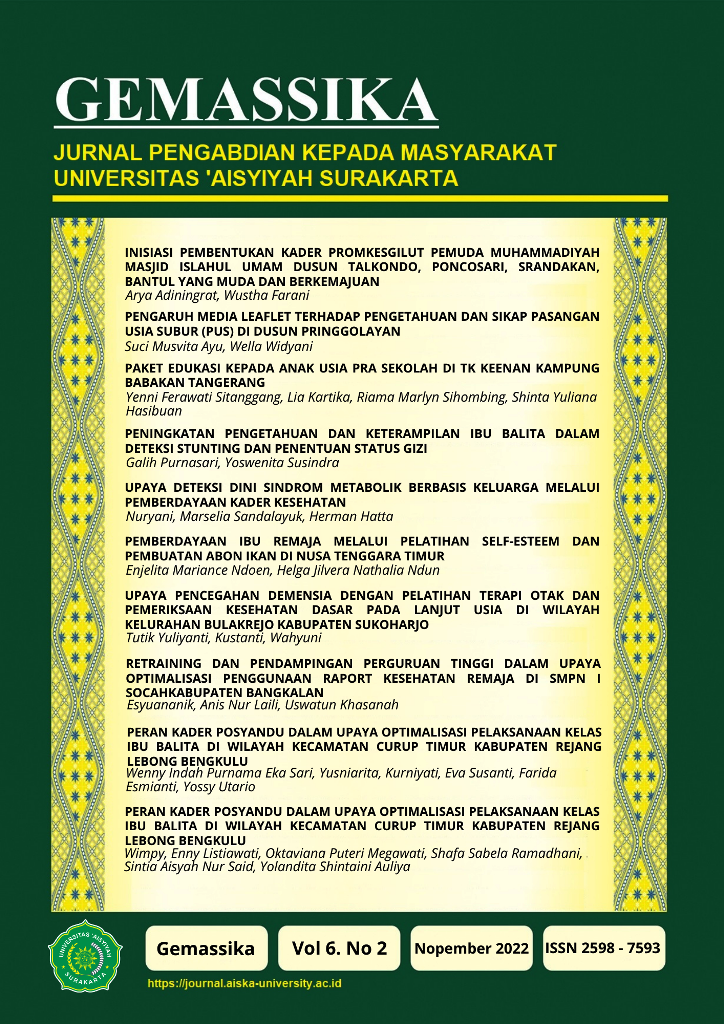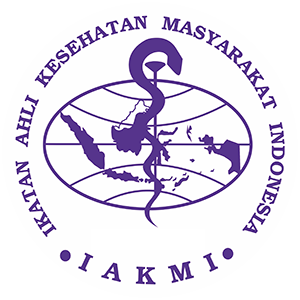PENINGKATAN PENGETAHUAN DAN KETERAMPILAN IBU BALITA DALAM DETEKSI STUNTING DAN PENENTUAN STATUS GIZI
DOI:
https://doi.org/10.30787/gemassika.v6i2.591Keywords:
stunting, determination of nutrional status, proteinAbstract
Stunting was a disruption growth problems because of deficiency nutritional intake in a long periode and unappropriate feeding practice. Riskesdas stated that Bondowoso’s stunting rate  was still the third highest in East Java. The stunting rate in Bondowoso was 38% of total childrens under five, meanwhile the threshold determined by WHO was 20%. This activity aimed to increase the knowledge about stunting and skills to determine the toddler’s nutritional status of the mother in TK Kartika IX-37 Bondowoso. This activity was conducted among 35 toddler’s mother in TK Kartika IX-37 Bondowoso. The details of the activity were (1) education about stunting;(2) demonstration about anthropometry measurement and read the Z score curve; (3) education about determined the appropriate source of protein. The results of this activity showed an increased in knowledge related to stunting and appropriate protein source for children growth, evidenced by the mothers were able to answer and demonstrated anthropometry measurement correctly.
ÂReferences
Danaei G, et al. 2016. Risk Factors for Childhood Stunting in 137 Developing Countries: A Comparative Risk Assessment Analysis at Global, Regional, and Country Levels. Plos Medicine 13(11): e1002164. https://doi.org/10.1371/journal.pmed.1002164
Dewey, KG, dan Begum, K. 2011. Longâ€term consequences of stunting in early life. Maternal & child nutrition, 7(3): 5-18.
Gibney MJ, Margetts BM, Kearney JM, dan Arab L. 2009. Gizi Kesehatan Masyarakat. Jakarta: Kedokteran EGC.
Global Nutrition Report. 2014. Actions and Accountability to Accelerate the World’s Progress on Nutrition. International Food Policy Research Institute.
Hardinsyah, Riyadi H, Tambunan V. 2014. Kecukupan energi, protein, lemak dan karbohidrat dalam angka kecukupan gizi yang dianjurkan bagi bangsa Indonesia. Jakarta: Direktorat Jenderal Bina Gizi dan Kesehatan Ibu dan Anak Kemenkes.
Mikhail WZA, Sabhy HM, El-sayed HH, Khairy SA, Salem HYHA, Samy MA. 2013. Effect of nutritional status on growth pattern of stunted preschool children in Egypt. Acad J Nutr; 2(1): 1-9.
Mugianti S, Mulyadi A, Anam AK, Najah ZL. 2018. Faktor penyebab anak Stunting usia 25-60 bulan di Kecamatan Sukorejo Kota Blitar. Jurnal Ners dan Kebidanan. Volume 5, Nomor 3, Desember 2018, hlm. 268–278
Ni’mah K dan Nadhiroh SR. 2015. Faktor yang Berhubungan dengan Kejadian Stunting Pada Balita. Media Gizi Indonesia, Vol. 10, No. 1 Januari–Juni 2015: hlm. 13–19.
Oktarina Z dan Sudiarti T. 2014. Faktor Risiko Stunting pada Balita (24-59 bulan) di Sumatera. Jurnal Gizi dan Pangan . Vol 8: No 3: 175-180.
UNICEF. 2013. Maternal and Child Nurition. Issues Briefs.
[WHO] World Helath Organization. 2010. Nutrition landscape information system (NLIS) country profile indicators: intrepretation guide. Diakses pada 24 April 2018.
UNICEF. 2010. Issue Briefs Maternal and Child Nutrition.
Downloads
Published
How to Cite
Issue
Section
License
Copyright (c) 2022 GEMASSIKA : Jurnal Pengabdian Kepada Masyarakat

This work is licensed under a Creative Commons Attribution-NonCommercial 4.0 International License.












